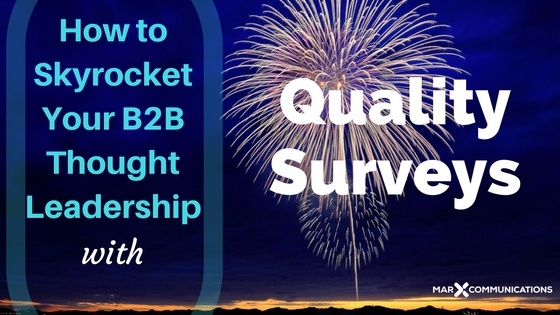As B2B marketing strategies continue to evolve, surveys become a valuable and persuasive resource. Insightful research combined with shrewd marketing strategies create an unbeatable recipe for B2B thought leadership. Let’s look at how this is done.
The Relationship Between B2B Thought Leadership and Surveys
Let’s first answer the question, what is thought leadership? Thought Leadership Lab defines the concept this way: “Thought leaders are the informed opinion leaders and the go-to people in their field of expertise.”
Independent research can help position your company as a thought leader in your industry. –Shauna Ward
People want statistics, numbers, facts, data — this is what convinces people. It adds credibility to your work. What happens when you offer up surveys in your content? Your prospects, media (and B2B buyers) are drawn in by your evidence. For example, you can say that demand for your product has surged or alternatively say that it is up five times over last year. The specificity helps establish your bona fides.
At the same time, surveys create news and help define a field. HubSpot, for instance, yearly releases with much fanfare its much quoted State of Inbound Marketing report.
Let’s look at specific methods your company can use to leverage surveys in your marketing to generate both B2B thought leadership.
Stand Out From the Crowd
With content creation a top priority for every business, buyers are inundated on a daily basis — in and out of the B2B sector. What can make your company different?
Amidst this endless sea of content, surveys can be a refreshing and welcome change. Surveys help you produce original content and establish benchmarks in your industry. Wouldn’t you like to be the person helping to define your industry?
Build Your Credibility
Buyers have a tendency to distrust brand-centric content from the start. It’s easy to dismiss it as marketing fluff. So, don’t focus on your brand’s products and solutions in your content. Instead, showcase your knowledge and insight on market trends and statistics — as gleaned from your survey — to carry more weight with prospective buyers.
Survey results give your reader the chance to benchmark their experience against that of their peers. –Katie Martell
Create compelling commentary on your research and present progressive and enterprising ideas based on it. This will help establish your B2B thought leadership.
Quinnipiac University is an excellent example of this. The university has successfully used surveys to boost its brand, transforming a regional school into a national presence. Using surveys, the university has garnered attention from major news outlets, including The Washington Post, The New York Times, and CNN.
Mold Your Surveys Into Appealing Content
Let’s face it — even though surveys are reliable and informative — the raw data often has all the appeal of wet cardboard. You need to turn this data into content that will appeal to and engage a wider audience. Here are some ways to do just that:
- B2B thought leadership report
- Social media posts with key stats
- A press release for target, niche publications
- Multiple blog posts
- eBook of best practices
- Infographic of key stats in a visually appealing format
- Quiz showing visitors how they measure up to the findings
- Video Q & A that leverages these key stats
- SlideShare content
Get industry-leading bloggers to link to this content, and it will strengthen your search engine ranking. Don’t however wait to the last minute. Pre-announce your upcoming survey to influential bloggers, asking it they’d like to get a sneak peak ahead of time. This will help create a well of support. Also post a full survey report on your site so bloggers and media will link to it. This impresses those elusive search engine elves, and also improves the traffic to your site.
Boost Your PR Thought Leadership
Perk any journalist’s interest with attention-grabbing, one-of-a-kind data that impacts your industry. Reporters can sometimes receive hundreds of emails from companies trying to capture their interest, and inspire coverage. How can you grab their attention?
Journalism is all about storytelling. The key to procuring media coverage is to create a story that reporters will be persuaded to tell. Craft your survey into a story that will whet a journalist’s appetite. What insight does this data offer on the future of your industry? Offer an interview on the survey’s findings with your company’s CEO, or a glimpse at how companies can benefit from the data. Do everything you can to make the reporter’s job easier while ensuring your data comes alive.
Equip Your Sales Team with Authority
Your sales team is representing you on the front lines — fighting for your company. It’s your job to equip them with timely tools to get the job done. Surveys are a powerful tool when wielded by a seasoned sales team.
Think about it — how better to convince potential buyers to work with you than to generate a sense of trust, or even urgency. Surveys can be the key to unlocking these emotions, and beginning the purchasing process.
Surprise Customers by Revealing a Need
Customers who don’t see a need won’t pay attention — period. This false sense of security is what you need to break through if they are going to take you seriously. Show them that you know the industry, including the unseen threats that even they many not realize.
Shake them out of their comfort zone by revealing a pain point that needs attention. Use your research to shine a bright light on problem areas that the industry as a whole needs to address. In what areas are they wasting precious resources? How can they be more efficient? Once they understand a legitimate need, you’ll have their attention.
Thought leaders are perceived as being entrenched in the pains that exist in the market. –Glenn Gow
Once you have their attention and you have demonstrated you understand their needs — then and only then — can you talk about how your product or service can solve their problem.
Ultimately, surveys done right are an important component that takes your company from status quo to thought leader. Have you tapped into this key marketing strategy? If not, now’s the time.

